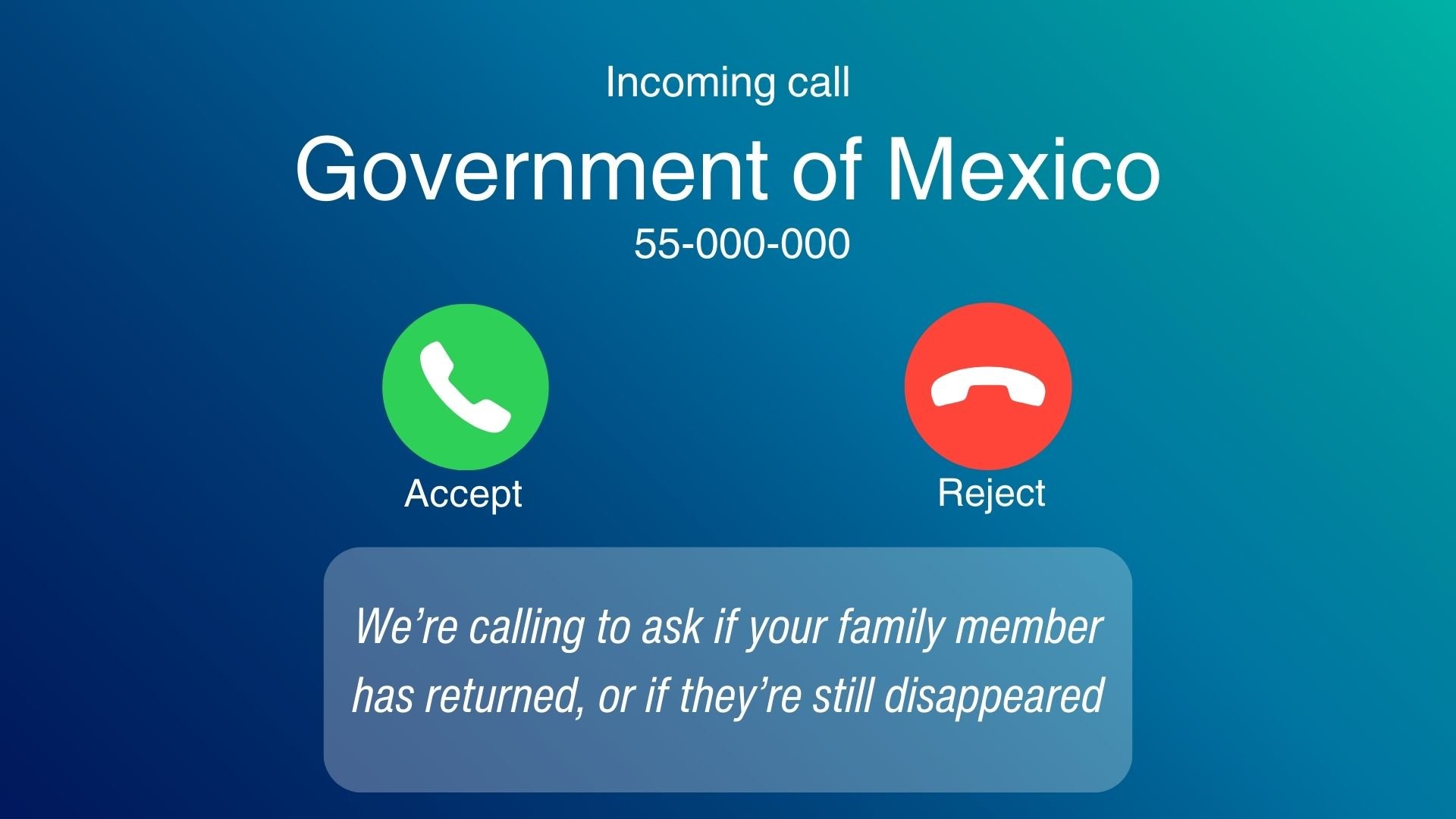Inside the Mexican government’s strategy to ‘disappear the disappeared’
Illustration by María José López @M_X_J.
Reportage • Lucía Flores and Germán Canseco • October 5, 2023 • Originally published by A dónde van los desaparecidos on September 18, 2023 • Leer en español
The Mexican government created a call center run by Ministry of Security and Citizen Protection (SSPC) staff in an effort to "update" the National Registry of Disappeared and Missing Persons (RNPDNO), according to sources involved in the effort. In the face of the emergency represented by more than 111,000 recorded disappearances, the new national search strategy consists of making phone calls to verify information and try and lower this figure, which is increasing by an average of one person an hour.
"Is your relative okay or are they still missing?" This is the question that a caller calling on behalf of the government of Mexico asks whoever answers the phone in homes where there's an indication that a person reported disappeared may have returned. This procedure was verified by A dónde van los desaparecidos. Two people make the calls also described how they work.
This latest update of the RNPDNO began after several complaints following "door-to-door" visits by search commission staff, often accompanied by police, National Guard agents or civil servants. They questioned families about the return of their missing family member and, in some cases, even went so far as to inspect their homes.
During one of the phone calls, a call center worker stated: "The goal is to take down the names of people who have returned; in the case of your family member, we are going to keep them on record [because they are still missing]."
"Our job is to call people who have an active report of disappearance,” said one of the callers interviewed for this investigation. “The truth is that there are still people who have one, but that are now reunited with their relatives, and we're satisfied because we've found many cases".
Telephone records show the list of phone numbers being called is under the jurisdiction of the Ministry of the Interior (Segob), but the callers work for the SSPC.
One of the call center workers, who requested anonymity, said the calls are part of a permanent program. The line operates 24 hours a day and makes it possible to contact people who have a family member with an "active report."
"The reason we're calling is to find out if your relative is safe and sound, or if they're still disappeared," he said, explaining how he speaks to the families.
Silvia Ortiz, spokesperson for Grupo Vida (Victims for our Rights in Action), a search collective in Coahuila, said these actions show the lack of commitment at the municipal, state and federal levels to search for people as soon as they go missing. "How dare they ask if [our relative] is still disappeared when the case file speaks for itself, and that case file is supposed to be based on an investigation?" she asked, outraged.
Both SSPC callers we spoke to stated that the calls are the second phase of the process of updating the national registry, which President Andrés Manuel López Obrador launched on June 9, referring to it as "new census." The first phase consisted of a cross-referencing of data between the RNPDNO and Covid-19 vaccination records. Then, personnel from various states' search commissions were sent to the homes of disappeared persons' families to verify matches by asking them if their relative had returned.
Even though government protocols released in response to a transparency request advise against visiting homes without prior warning as families may consider it to be re-victimizing, government representatives went ahead and visited the homes of people who are still disappeared without providing their families with information on their whereabouts or any new details on their case.
A mystery methodology
The government hasn't disclosed its methodology for updating the RNPDNO. The collectives that make up the Movement for Our Disappeared in Mexico have warned it could be an attempt to shrink the database.
After the resignation of Karla Quintana, the head of the National Search Commission (CNB) on August 23rd, rumors flew that her departure was due to her disagreement with the method ordered by López Obrador to purge the RNPDNO. Specialist Jacobo Dayán said in a statement to A dónde van los desaparecidos that this could be read as a refusal by Quintana to try to "trim" the registry. Upon leaving office, Quintana published an incomplete version of the RNPDNO.
A government source who asked to remain anonymous, gave another version: given the lack of results on the part of the CNB in reducing the number of disappearances, the President's Office asked the Minister of Security and Citizen Protection, Rosa Icela Rodríguez, to take charge of the latest phase of the national registry update.
"When the process started we didn't know anything about it, we didn't know where it came from, and that makes it even more problematic, coming as it does from the Presidency,” said Juan Carlos Trujillo Herrera, member of the National Search Brigade, who was taken by surprise by the door-to-door visits. “Andrés Manuel took the initiative to try to reduce the number of disappeared people in the country, but in statistical terms only."
After learning about such a "search" plan carried out by the SSPC, Manuel Pérez Aguirre, a researcher at the Seminar on Violence and Peace at El Colegio de México, said this type of measure has distinctly political overtones. "Ahead of the coming elections, López Obrador and his ego can't afford to leave office with worse numbers than ex-president Felipe Calderón,” he said. “This is especially important for him." But "we are literally living in a mass grave called Mexico."
"From day one, this government's policy has been to disappear the disappeared," added Pérez Aguirre.
Sheinbaum's influence
The phone call approach to updating the RNPDNO came about back in February, when Claudia Sheinbaum, then head of government of Mexico City and now potential successor to the presidency with the Morena party, met with members of López Obrador's Security Cabinet. She bragged to the president about a decrease in the number of missing and disappeared persons during her administration after having implemented the calls, according to a source who was present at the meeting.
The president liked the idea. Upon Sheinbaum's suggestion, the CNB and the Subsecretariat of Human Rights developed a strategy of going door-to-door and visiting families of disappeared persons after cross-referencing the RNPDNO with Covid-19 vaccination records. Due to public criticism and complaints from victims, the President told the head of the SSPC to scale up the phone call model used by Sheinbaum in Mexico City.
One of the phone numbers SSPC operators call from appears at least eight times in websites such as quienhabla.mx and datostelefonicos.com, where people who receive problematic calls report extortion, fraud, and suspicious or annoying phone calls.
"Someone called from this number and said that one of my relatives was reported missing and that they wanted to get more information." "They asked if they were calling a landline or a mobile phone." "They asked for a disappeared person's name." "Someone called me and said they're from the Mexican government, looking for a disappeared person with my son's name; if anyone recognizes this number, please let me know," read some of the comments on these websites. Some are from Mexico City, and others from Monterrey.
Another person wrote:
I received a call from this number informing me that they had a disappearance report of one of my relatives on file. They asked to speak with that person (we were in the same room). They then told us they had to drop the report and that they needed some personal information, that it was something simple, to which we replied that we would go to the Public Prosecutor's Office to follow up. I asked for the disappearance report number to follow up and the caller told me (in a 'shaky' voice) that they would give me a phone number where I could confirm that the report was real, and that they didn't have the disappearance report number. The number they gave me was the same number they were calling from.
Phone calls from this number have been reported on websites since at least August 16, of this year. Commenters regularly state callers tried to obtain personal information by inquiring about someone who has disappeared. Although the callers introduce themselves as federal government officials, people distrust them.
The source we consulted, who works closely with the office of Alejandro Encinas, the Undersecretary of Human Rights, said that the people making the calls had received human rights training on how to carry out the procedure in a respectful manner and avoid re-victimizing the families. One of the options for building trust with wary people is to suggest a video call to verify that it is government employees who are calling them.
Questioned with regards to whether, after a phone call, they visit the families' homes, one caller said that when they get a negative answer, they simply register the person as "still disappeared" in the system. It is only if the person has returned that they visit their home.
"We conduct visits to people [registered as disappeared] if we've been told they are back with their families. They fill out a form and we take their picture to prove that they're alright," said the caller.
Callers' jobs are made more difficult, according to the source interviewed, because the RNPDNO can have double or even triple entries for the same disappearance, and there is insufficient verification of personal data, which, in some cases, is incorrectly recorded.
Confirming appearances
The Mexico City Attorney General's Office (FGJCDMX) drafted a step-by-step guide on how to locate a person who has disappeared, according to the same source. The document stipulates that, first, the RNPDNO be cross-referenced with various other databases.
Information from the Tax Administration Service is consulted to find out if the person has any economic activity on record; the National Electoral Institute is contacted to determine if they have changed their address; the Civil Registry is contacted to find out if their marital status has changed; and bank records are requested so as to detect any activity in their accounts.
When a match emerges or there's an indication that the disappeared person has carried out any of these activities, staff proceed to dial the number associated with that person to verify if they have been found. If the answer is yes, they request proof of life—a photograph with that day's newspaper—and carry out a home visit. They also ask the person to be videotaped saying the phrase "Yes, I was in the disappeared persons registry," and to fill out a form with their address, the date, their name and signature.
Call center workers are only provided with the disappeared person’s contact information and the data that pinged when databases were consulted. Their sole purpose is to verify whether people have returned home, and to gather information such as whether the person who answered the phone was the person reported as disappeared or a family member, and whether the person they're asking about has been located or found dead.
"The idea isn't very good overall… The whole process has been quite opaque," said Pérez Aguirre from the Colmex.
Elena Azaola, an anthropologist who is also a member of the Citizen Council of Mexico City’s Search Commission confirmed that the FGJCDMX showed her this protocol.
"This was the intended plan at the Mexico City Prosecutor's Office. I don't really know if it's being done as they promised, or with what results, since nothing has been made public," she said.
Azaola mentioned that the FGJCDMX told members of the Citizen Council that this process allowed them to locate people registered as disappeared, but that they hadn't specified how many, nor if they were found alive.
Azaola also expressed doubts about the government's capacity to search for "thousands and thousands" of people in their homes, considering that the prosecutor's offices are overwhelmed.
During the 447th session of the United Nations Committee on Enforced Disappearances (CED), held on September 13, the Mexican State was questioned about the census and its methodology.
Enrique Irazoque, head of the Unit for the Defense of Human Rights inside the Ministry of the Interior, responded that the "interoperability" of the RNPDNO with other databases and cross-referencing with different registries is part of the state’s legal obligation to carry out searches and locate people.
"And so, in recent months," explained Irazoque, "we have intensified this work and, from there, in the framework of generating cross-checks among important databases such as those of the social programs of the Government of Mexico, and of the National Population Registry, we have found proof of life of many people who appear to be included in the national registry."
The official defined the process as "a search program for living people that consists of the deployment of Mexican Government officials that is a federal policy decision, ordered by the President of the Republic himself."
The second stage of the update of the registry is being carried out despite there is no one at the head of the CNB, and on the heels of former CNB head Quintana's delivery of the database to the Inter-American Court of Human Rights.
"As long as the government doesn't follow proper procedures and work together with the families, no idea, no matter where it comes from, is going to succeed in finding the disappeared people of this country," said Trujillo, who is searching for his four missing brothers.
We requested an interview with Encinas to determine if the sub secretariat he leads was responsible for the human rights training of the SSPC personnel who make the calls but, as with other requests, we received no response.
As with the door-to-door visits, this strategy to update the national disappearance registry hasn't been presented to search collectives, relatives of disappeared persons, nor to society in general.
–
With additional reporting by Marcela Turati, Efraín Tzuc and Analy Nuño.
The team at A dónde van los desaparecidos does research and records what it can about the logic of disappearance in Mexico. This material may be freely reproduced, as long as credit is given to the author and A dónde van los desaparecidos.




